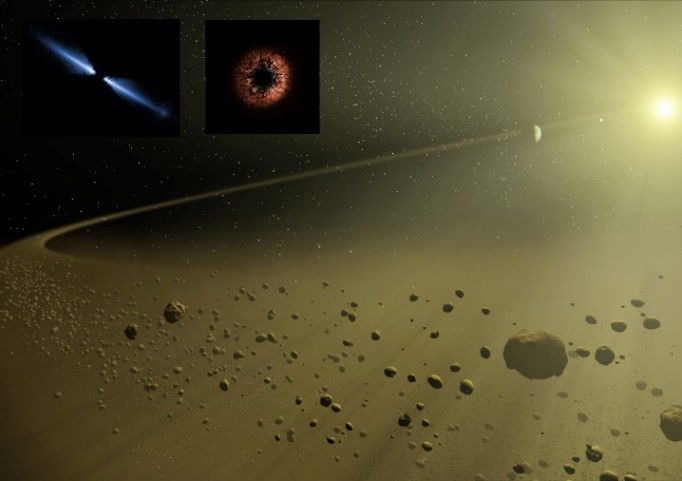Credit & Copyright: HST images
Explanation:
In this dramatic
artist's vision,
debris along the outer
reaches of a planet forming disk orbits in the
glare of a distant sun.
But inset are actual images of such
disks around two
nearby stars - AU Microscopii
(top left; edge-on) and HD107146 (right: face-on) -
as seen by the Hubble
Space Telescope.
Combined with
infrared images from the
Spitzer
Space Telescope that show debris disks around known planet bearing
stars, the data
provide the first direct link
between extrasolar
disks and planets, suggesting a
scenario where evolving planets scatter debris
produced by collisions
into giant disks.
In time, the dusty
disks may dwindle and become like our own
Solar System's comet reservoir, the
Kuiper Belt.
News: The answer to
Lewin's Challenge APOD can be found
here.
1999 2000 2001 2002 2003 2004 2005 2006 2007 2008 2009 2010 2011 2012 2013 2014 2015 2016 2017 2018 2019 2020 2021 2022 2023 2024 2025 |
Yanvar' Fevral' Mart Aprel' Mai Iyun' Iyul' Avgust Sentyabr' Oktyabr' Noyabr' Dekabr' |
NASA Web Site Statements, Warnings, and Disclaimers
NASA Official: Jay Norris. Specific rights apply.
A service of: LHEA at NASA / GSFC
& Michigan Tech. U.
|
Publikacii s klyuchevymi slovami:
disk - dust - extrasolar planet - disk, okolozvezdnyi - Planety u drugih zvezd - ekzoplaneta
Publikacii so slovami: disk - dust - extrasolar planet - disk, okolozvezdnyi - Planety u drugih zvezd - ekzoplaneta | |
Sm. takzhe:
Vse publikacii na tu zhe temu >> | |
